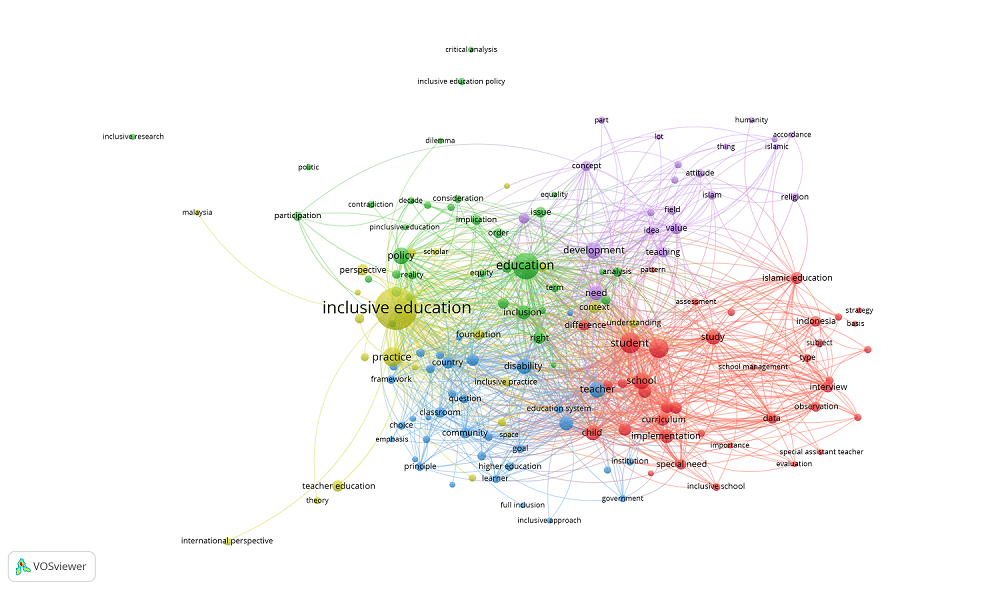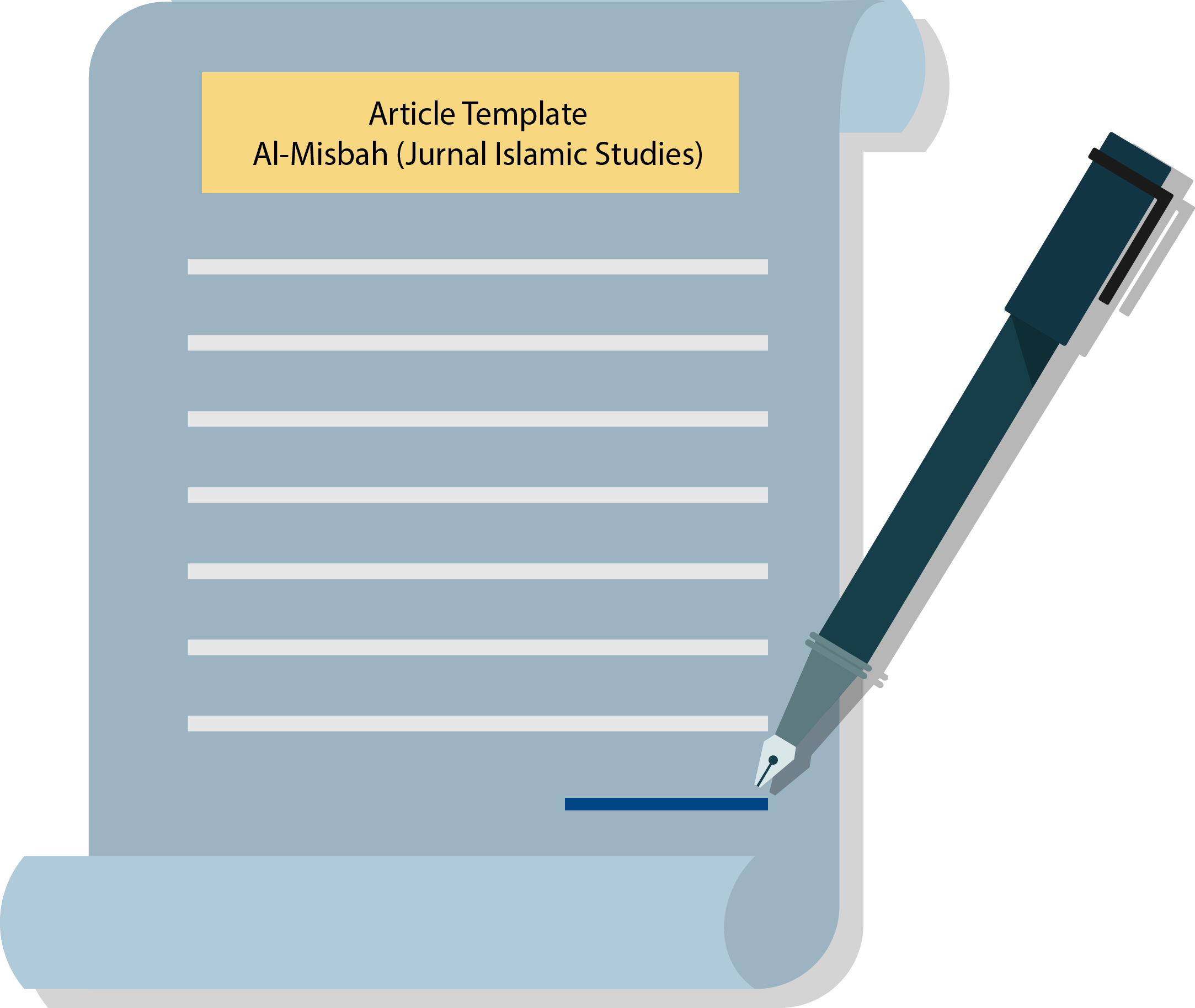Mapping the Landscape of Inclusive Education in Islamic Educational Contexts
DOI:
https://doi.org/10.26555/almisbah.v12i1.7988Keywords:
Inclusive Education, Islamic Education, Mapping the Landscape, BibliometricAbstract
In Islam, the concept of inclusive education is an important and timely topic that addresses the need for equitable and inclusive education for all individuals, regardless of ability, gender, social status, or background. This study aims to explore the research landscape on Inclusive Education in Islamic Educational Contexts with bibliometric methods. Data was collected with the Publish or Perish (PoP) application from a crossref database and then analyzed with the VosViewer application involving 200 databases. The surprising finding in this study is the absence of connection strength in this analysis may imply that the authors did not collaborate or connect in the dataset. In this study, authors have not connected, thus researchers in this field should build scientific links between authors and research issues. The study also shows that the clusters demonstrate how numerous factors, including national, religious, societal, and educational aspects, affect inclusive education in these locations. The clusters show that inclusive education in Islamic educational contexts is influenced by practical, policy, stakeholder, theoretical, and philosophical aspects, such as Islamic values, beliefs, and teachings and the requirements of learners with disabilities. The study emphasizes the need for equitable and inclusive education for all individuals, aligning with the principles and teachings of Islam that promote equality, dignity, and social justice. It sheds light on the contemporary relevance of inclusive education in Islamic educational settings and raises awareness of the significance of addressing the diverse needs of learners, including those with disabilities.
References
Ackah-Jnr, F. R., & Danso, J. B. (2019). Examining the physical environment of Ghanaian inclusive schools: how accessible, suitable and appropriate is such environment for inclusive education? International Journal of Inclusive Education, 23(2), 188–208. https://doi.org/10.1080/13603116.2018.1427808
Afrianty, D. (2019). Disability inclusion in Indonesia: The role of Islamic schools and universities in inclusive education reform. Contentious Belonging: The Place of Minorities in Indonesia, 95–112.
Alharbi, A., & Madhesh, A. (2018). Inclusive education and policy in Saudi Arabia. International Journal of Education Research and Reviews, 6(1), 946–956.
Alves, I., Campos Pinto, P., & Pinto, T. J. (2020). Developing inclusive education in Portugal: Evidence and challenges. PROSPECTS, 49(3-4), 281–296. https://doi.org/10.1007/s11125-020-09504-y
ARMSTRONG, F. (1999). Inclusion, curriculum and the struggle for space in school. International Journal of Inclusive Education, 3(1), 75–87. https://doi.org/10.1080/136031199285200
Beveridge, S. (2005). Children, families and schools: Developing partnerships for inclusive education. Psychology Press.
Glänzel, W., & Schubert, A. (n.d.). Analysing Scientific Networks Through Co-Authorship. In Handbook of Quantitative Science and Technology Research (pp. 257–276). Kluwer Academic Publishers. https://doi.org/10.1007/1-4020-2755-9_12
González, L.-M., García-Massó, X., Pardo-Ibañez, A., Peset, F., & Devís-Devís, J. (2018). An author keyword analysis for mapping Sport Sciences. PLOS ONE, 13(8), e0201435. https://doi.org/10.1371/journal.pone.0201435
Halinen, I., & Järvinen, R. (2008). Towards inclusive education: the case of Finland. PROSPECTS, 38(1), 77–97. https://doi.org/10.1007/s11125-008-9061-2
Ilyas, E. L., Setyaningrum, N., & Sumarni, S. (2022). A Model of Inclusive Education Curriculum in Islamic Education Institutions: A Case Study in Banten Province, Indonesia. Jurnal Pendidikan Agama Islam, 19(2), 193–206. https://doi.org/10.14421/jpai.2022.192-02
Kalambouka, A., Farrell, P., Dyson, A., & Kaplan, I. (2007). The impact of placing pupils with special educational needs in mainstream schools on the achievement of their peers. Educational Research, 49(4), 365–382. https://doi.org/10.1080/00131880701717222
Khan, G. F., & Wood, J. (2015). Information technology management domain: emerging themes and keyword analysis. Scientometrics, 105(2), 959–972. https://doi.org/10.1007/s11192-015-1712-5
Liu, X., Bollen, J., Nelson, M. L., & Van de Sompel, H. (2005). Co-authorship networks in the digital library research community. Information Processing & Management, 41(6), 1462–1480. https://doi.org/10.1016/j.ipm.2005.03.012
Mahfud, C., Rohani, I., Nuryana, Z., Baihaqi, M., & Munawir, M. (2023). Islamic education for disabilities: new model for developing Islamic parenting in Integrated Blind Orphanage of Aisyiyah. Indonesian Journal of Islam and Muslim Societies, 13(1), 115–142. https://doi.org/10.18326/ijims.v13i1.115-142
Opertti, R., & Brady, J. (2011). Developing inclusive teachers from an inclusive curricular perspective. PROSPECTS, 41(3), 459–472. https://doi.org/10.1007/s11125-011-9205-7
Rahman, M. (1994). A holistic and institutional analysis of Islamic education. American Journal of Islam and Society, 11(4), 519–531.
Risnawati, E. (2019). Inclusive education paradigm in islam. Proceedings of International Conference on Special Education, 3.
Salim, N. (2021). Instructing a model of inclusive Islamic education. Journal Education Multicultural of Islamic Society, 1(1), 32. https://doi.org/10.33474/jemois.v1i1.10096
Singal, N. (2005). Mapping the field of inclusive education: a review of the Indian literature. International Journal of Inclusive Education, 9(4), 331–350. https://doi.org/10.1080/13603110500138277
Sulasmi, E. (2022). The Inclusive Education: An Islamic Education Perspective. Aksaqila Jabfung.
van Eck, N. J., & Waltman, L. (2010). Software survey: VOSviewer, a computer program for bibliometric mapping. Scientometrics, 84(2), 523–538. https://doi.org/10.1007/s11192-009-0146-3
van Eck, N. J., & Waltman, L. (2017). Citation-based clustering of publications using CitNetExplorer and VOSviewer. Scientometrics, 111(2), 1053–1070. https://doi.org/10.1007/s11192-017-2300-7
Visser, M., van Eck, N. J., & Waltman, L. (2021). Large-scale comparison of bibliographic data sources: Scopus, Web of Science, Dimensions, Crossref, and Microsoft Academic. Quantitative Science Studies, 2(1), 20–41. https://doi.org/10.1162/qss_a_00112
Wahyuningsih, S. (2016). Inclusive education for persons with disabilities: the islamic perspective. QIJIS (Qudus International Journal of Islamic Studies). https://doi.org/http://dx.doi.org/10.21043/qijis.v4i1.1547
Zulkifli, H., Rashid, S. M. M., Mohamed, S., Toran, H., Raus, N. M., & Suratman, M. N. (2022). Challenges and Elements Needed for Children with Learning Disabilities in Teaching and Learning the Quran. Children, 9(10), 1469. https://doi.org/10.3390/children9101469

Downloads
Published
How to Cite
Issue
Section
License
Copyright (c) 2024 Zalik Nuryana, Che Zarrina Sa’ari , Hamed A. Ead , Shazia Malik

This work is licensed under a Creative Commons Attribution-ShareAlike 4.0 International License.
Authors who publish with Al-Misbah agree to the following terms:
- Authors retain copyright and grant the journal right of first publication with the work simultaneously licensed under a Creative Commons Attribution License (CC BY-SA 4.0) that allows others to share the work with an acknowledgment of the work's authorship and initial publication in this journal.
- Authors are able to enter into separate, additional contractual arrangements for the non-exclusive distribution of the journal's published version of the work (e.g., post it to an institutional repository or publish it in a book), with an acknowledgment of its initial publication in this journal.
- Authors are permitted and encouraged to post their work online (e.g., in institutional repositories or on their website) prior to and during the submission process, as it can lead to productive exchanges, as well as earlier and greater citation of published work.

This work is licensed under a Creative Commons Attribution-ShareAlike 4.0 International License.



